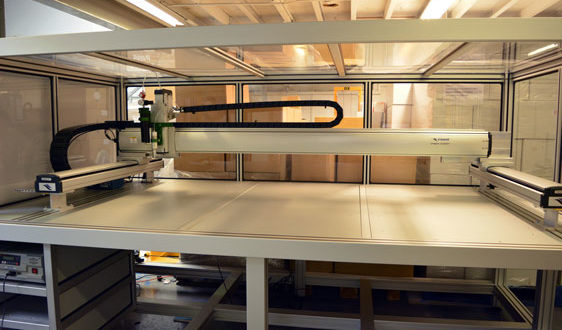Automated application of adhesives, potting compounds or encapsulants, sealants, FIP gaskets, temporary masking, lubricants, or other liquids, fluids or pastes provides productivity benefits over manual application, including consistency, speed and accuracy.
As selection of a dispensing robot is sometimes a daunting task, Intertronics, a specialist adhesives and dispensing company, has compiled a short piece of guidance on how to specify a dispensing robot.
When specifying a dispensing robot, it is important to understand that a so-called dispensing robot consists of four main components: the robot itself; the dispensing equipment; tooling to attach the dispenser to the robot and to hold the parts to be dispensed on; and an enclosure to protect both the robot and its users.
Each of these components can be specified separately, but need to be compatible with each other to ensure a complete and fully operational system.
The equipment supplier should be able to assist with this, and may have suggestions for a complete system based on the customer’s application.
The list of considerations for the components of a dispensing robot include work area, Z height, number of axes, weight of parts, weight of payload, load/unload process, accuracy, tolerance and repeatability.
All of these are explained in greater detail, along with leading questions, in the full guidance.
Depending on application requirements, there are several dispensing methodologies to consider.
The supplier should be able to help discern the most suitable methodology for the application and requirements, as well as with assembly and integration of the completed dispensing robot.
Assembly and integration
Once the dispensing robot has been specified, purchased and delivered, full training should be given to all users. This may be available from the equipment supplier.
Explains Intertronics MD Peter Swanson: “Automating the dispensing process can have significant effects on productivity and product quality.
“Robots, particularly bench-top robots, offer fast return on investment and a good level of capability when coupled with appropriate dispensing equipment.
“We have seen substantial improvements in consistency, speed, accuracy and reliability of the dispensing process with our customers who have implemented automated dispensing. This leads to cost savings in materials, production times and reduced rework.
“We have compiled “How to specify a dispensing robot” to help others toward that first step in the process, but we are also happy to walk through the specification process in detail with technology manufacturers who are considering automating their dispensing process.
“We can, of course, supply all of the components as a completed robotic dispensing system with process integration and training.”
The full guidance can be found HERE.
WACKER Signs Up Intertronics for silicone distribution
Munich-based chemical company WACKER and Intertronics tannounce the signing of a distribution contract under which Intertronics will sell WACKER’s range of RTV silicone encapsulants and potting compounds, adhesive sealants, and thermally conductive compounds to customers in the UK and Ireland.
Intertronics’ customers are involved in technology manufacturing in areas such as electronics, lighting, automotive, defence and aerospace.

WACKER’s silicone rubber products are used as sealants and gaskets, adhesives, and protective potting and encapsulation materials – applications which are very familiar to the Intertronics team.
Thermal management is another demand, as electronics designs continue to pursue increasing power in smaller circuits. Thermally conductive silicones provide an answer to controlling the resultant heat.
Peter Swanson, MD of Intertronics explains: “Silicone chemistry offers great benefits for our customers, including outstanding long term temperature stability, very good chemical resistance and long-lasting flexibility.
“It is a strategically important and synergistic addition to our range, adding extended capability. We are very excited to be working with WACKER with its huge resources and strong brand.”
Gabriele Thye, Managing Director of WACKER’s UK sales region adds: “We welcome Intertronics as a WACKER distributor. Their position as a trusted advisor to the market and their renowned high level of customer service will be key to generating many new mutual customers.”
 Engineer News Network The ultimate online news and information resource for today’s engineer
Engineer News Network The ultimate online news and information resource for today’s engineer






